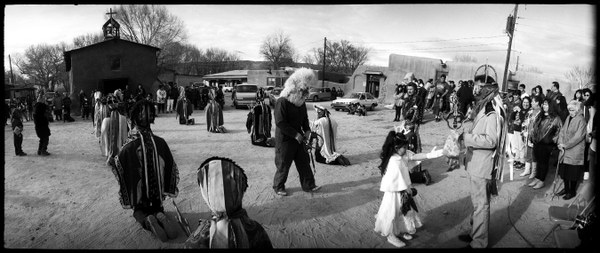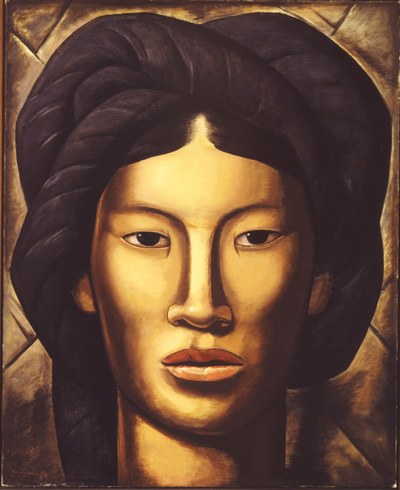Traitor, Survivor, Icon: The Legacy of La Malinche
June 11–September 4, 2022

Miguel Gandert, born 1956 Española, New Mexico; lives Albuquerque, New Mexico, El Poder de la Malinche, Alcalde, 1996, inkjet pigment print from scanned negative, lent by the artist
Alfredo Ramos Martínez (Mexican, 1871–1946), La Malinche (Young Girl of Yalala, Oaxaca), 1940. Oil paint on canvas; 50 x 40 1/2 in. Phoenix Art Museum: Museum purchase with funds provided by the Friends of Mexican Art, 1979.86. © The Alfredo Ramos Martínez Research Project, reproduced by permission
Traitor, Survivor, Icon: The Legacy of La Malinche was organized by the Denver Art Museum. This exhibition was made possible in part by a major grant from the National Endowment for the Humanities: Democracy demands wisdom. Additional funding was provided by Furthermore: a program of the J.M. Kaplan Fund. Special thanks to the National Institute of Anthropology and History and Mexico’s Secretary of Culture.
Any views, findings, conclusions or recommendations expressed in this exhibition do not necessarily represent those of the National Endowment for the Humanities.


Additional support is provided by the City of Albuquerque Department of Arts & Culture and the Albuquerque Museum Foundation.
CATALOG
As the first exhibition to explore the subject visually, it was accompanied by a fully-illustrated scholarly catalog for a general audience that was conceived as both a companion and a stand-alone volume that will remain relevant long after the exhibition. Catalog content explored in depth the context and history of Malinche, and followed generally the exhibition's sections while elaborating more fully on those thematic ideas.
Traitor, Survivor, Icon: The Legacy of La Malinche examined the historical and cultural legacy of the Indigenous woman at the heart of the Spanish Conquest of Mexico (1519-1521). A controversial and enigmatic figure with a complicated life story, the woman known colloquially as Malinche played a central role in the major and minor transactions, negotiations, and conflicts between the Spanish and the Indigenous populations of Mexico. Traitor, Survivor, Icon established and examined her symbolic importance and the ways artists, scholars, activists, and everyday women have used her story and image as means of expression.
The exhibition premiered at the Denver Art Museum earlier in 2022 and was co-curated by Denver Art Museum’s Curator of Art of the Ancient Americas Victoria I. Lyall and independent curator Terezita Romo.
The year 2021 marked the quincentennial of the fall of Tenochtitlan, capital of the Aztec Empire. In 1519, Spanish conquistador Hernando Cortes landed along the Gulf coast of Mexico with a small expeditionary party. As he and his men interacted and fought with the Maya and Nahuatl speaking peoples of the region, language was a nearly insurmountable barrier. When they reached the present-day state of Tabasco on the Gulf of Mexico, Cortes received a gift of twenty young women from a local ruler. One of them was a teen-aged girl who was baptized Marina and later referred to as Malinche. Though her origins remain obscure, she clearly had ties to the region, and was fluent in both Nahuatl and Maya. She skillfully leveraged her linguistic gifts in order to survive. Over the course of the next two years, as the Spanish and their Tlaxcalan allies suffered setbacks and eked out victories before their final triumph over the Aztec in August of 1521, Malinche would become Cortes' translator, cultural interpreter, and eventually, the mother of their child. While her original name is lost to history, both Spanish and Indigenous accounts of the Aztec Spanish Waragree on the pivotal role this young woman played in one of the most significant events of modern history.
Traitor, Survivor, Icon: The Legacy of La Malinche reconsidered the iconic figure. While she has been the subject of numerous historical works, no exhibition had presented a comprehensive visual exploration of Malinche and the continued importance of her image in discussions and ideas about the role of women, indigeneity, and language throughout the Americas. Traitor, Survivor, Icon will thus established and examined her symbolic import and the ways artists, scholars, activists, and everyday women have used her story and image as means of expression related to their own situations or agendas.
There is no record of Malinche in her own voice, or even of her true name; she was eventually baptized 'Marina' by Spanish priests, an apparent approximation of the Nahuatl honorific Malintzin, which may have derived from the calendrical sign for the day Malina/li, or 'Grass'. In this absence, this exhibition aimed to examine the conditions that have led to, at different times, the appropriation and adaptation of Malinche for the purposes of enacting cultural and political identities. As a historical persona, Malinche has been adopted and adapted in text, image, and object countless times in the five hundred years since the Conquest. In order to understand Malinche and the multiple roles she played, these iterations of Malinche must be examined side by side.
Drawing on earlier work by curator Terezita Romo, the exhibition considered five distinct archetypes, or metaphors, embodied by Malinche over time, beginning with La Lengua / The Interpreter, which considers her role as translator and interpreter. La Mujer lndigena / The Indigenous Woman explores the archetype of Indigenous women living in pre-Conquest Mexico. La Madre de Mestizaje / The Mother of a Mixed Race presents Malinche as the perceived mother of the mestizo identity of post-Conquest Mexico. La Traidora / The Traitor examines perceptions of her supposed treachery or cultural and ethnic betrayal. Chicana carries her story into the twentieth century when Chicano writers and artists reclaimed Malinche as heroine, survivor, and inspiration. To make sense of these archetypes, the exhibition opened with an introductory section meant to establish the historical, cultural, chronological, and geographical contexts for the Conquest of Mexico, and thus the setting into which Malinche emerges.
Albuquerque Museum's presentation of Traitor, Survivor, Icon: The Legacy of La Malinche included additional works by New Mexican artists that connect the iconic figure to the Land of Enchantment. "These celebrated New Mexican artists enrich the stories of Malinche that traverse time and place and create important connections to New Mexican cultural traditions that are both connected to and different from the many meanings attached to Malinche in other parts of the United States and Mexico," said Albuquerque Museum's Curator of Art Josie Lopez, Ph.D. Altarpieces by Vicente Telles, Brandon Maldonado, and Okuu Pin’ (Jason Garcia) explored the history of the Aztec-Spanish war as well as the significance of Malinche within the Indigenous and Mestizo communities of New Mexico who practice the Matachine dances. Photographers Miguel Gandert and Douglas Kent Hall also captured these ritual dances in communities throughout the state. Delilah Montoya's codex situates Malinche within a universe of important female icons that have shaped Chicana identity for centuries.
Like the quincentennial of Columbus' voyage in 1992, anniversary of the Conquest was a moment to reflect on how the ideas of agency and identity that mark Malinche's story remain relevant today. Her position as a woman with privileged access to the predominantly male structures of political power on both sides prompts questions about the role of women in society then and now. As an Indigenous person, her participation and facilitation implicates her as complicit, rightly or wrongly, with the subjugation of her own people, surfacing issues of race and identity that echo in today's news cycles. As a figure embraced by Chicana artists, they reframed her narrative to underscore the emergence of an invigorated Chicana feminism resisting against earlier negative interpretations. Contemporary issues explored through the emergence of a new-generation Latinx movement underscore the fluidity of gender identity and roles in the twenty-first century. In light of identity politics at the forefront of national conversations, an examination of a singular figure of cultural appropriation is indeed timely. Malinche's story has contemporary resonances that visitors will understand and appreciate.
WATCH PLAYLIST — Codex Delilah: Six Deer a Journey from Mechica to Chicana
Delilah Montoya’s contemporary codex (book-form manuscript) tells the story of Six Deer, an Indigenous girl, whose journey brings her in contact with heroines of Mexican and Chicana history, including Llora-Llora-Malinche, a combination of Malinche and La Llorona. Popular in Mexican folklore, La Llorona was abandoned by her husband and drowned her children in desperation. Both Malinche and La Llorona are symbols of betrayal. Six Deer later encounters renowned women like Sor Juana, Adelita, and Old Crow Woman. Throughout the Codex, time is marked by date glyphs ending in 2012, signaling the entry into a new era. As the deities in the upper register look on, Six Deer travels through time engaging with these important icons and the struggles they encounter. In the end, the deities in the upper register are warring with each other as Six Deer saves Old Crow Woman, transcending time and worlds.
Codex #2 Delilah: Six Deer: A Journey from Mechica to Chicana, 1992 – 1995, painted amate paper on board, photographs, and string, Department of Special Collections, Stanford Libraries
Panel 1
Panel 2
Panel 3
Panel 4
Panel 5
Panel 6
Panel 7


